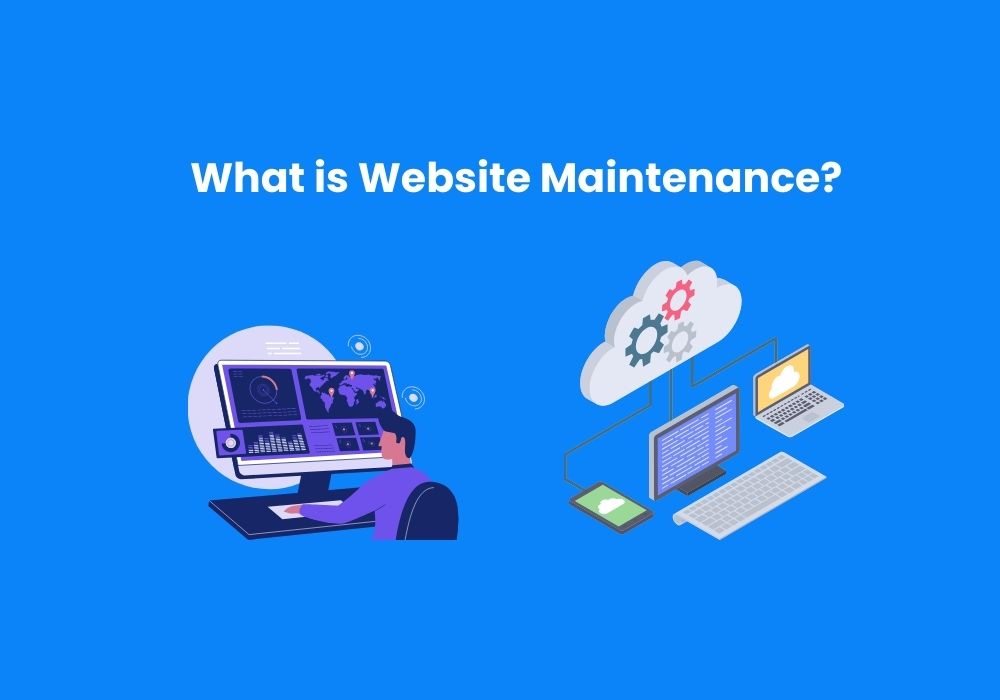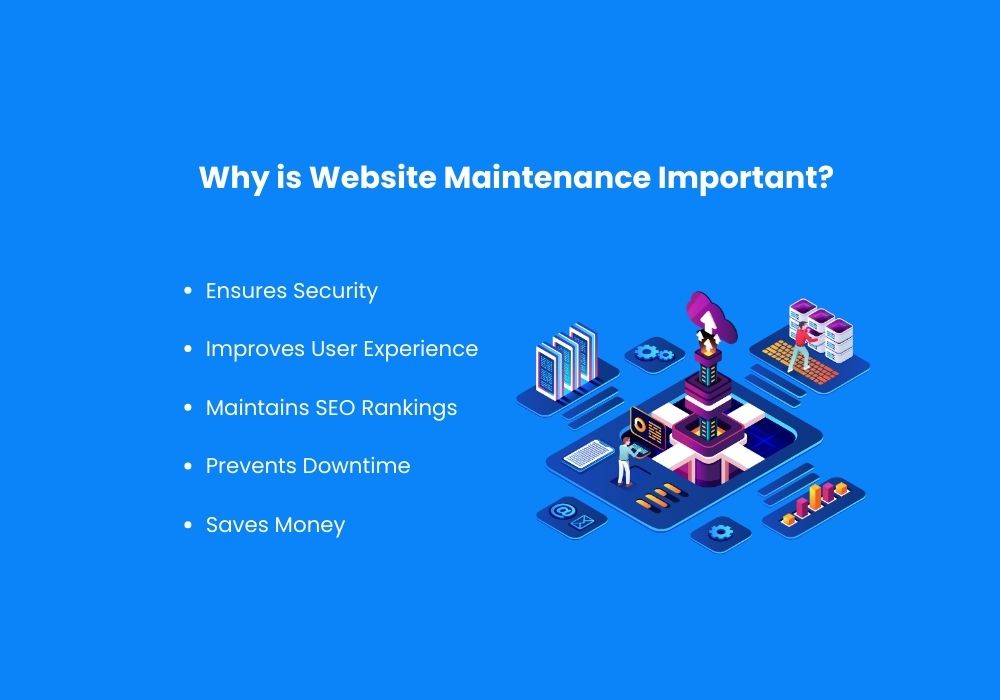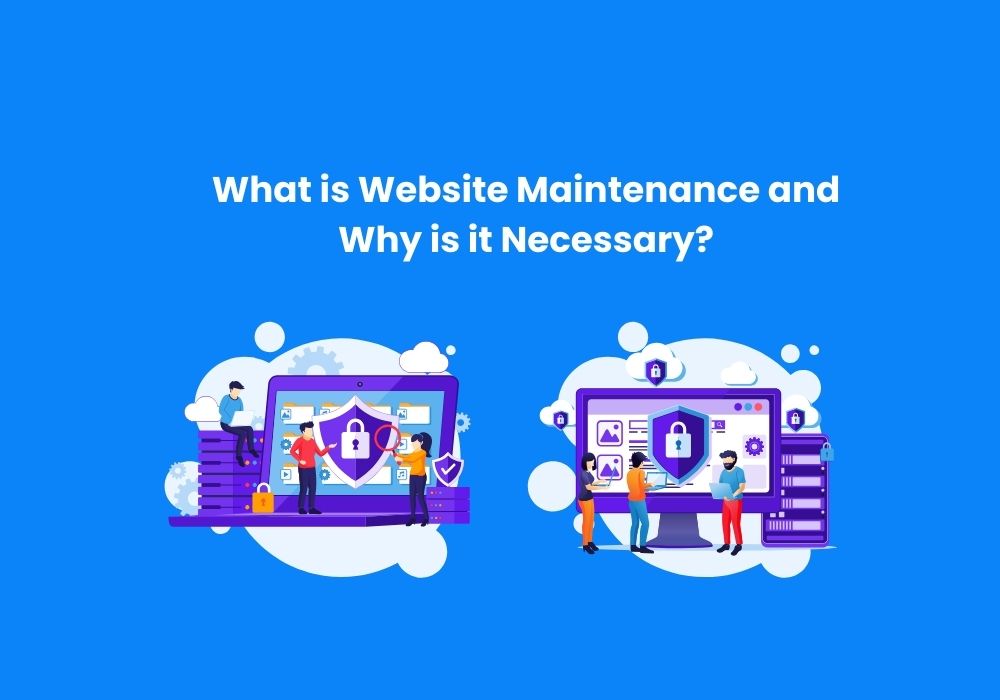What is Website Maintenance and Why is it Necessary?
In today’s fast-paced digital world, a website is often the face of a business or brand. Regular website maintenance is crucial to ensure that your site runs smoothly, remains secure, and provides an excellent user experience. Website maintenance involves the routine checking and updating of a site to keep it running smoothly, secure, and relevant.
Without regular maintenance, a website can become slow, vulnerable to cyberattacks, and outdated, which can negatively affect user experience and search engine rankings. In this blog post, we will walk you through the concept of website maintenance, why it’s necessary, and a step-by-step guide on how to maintain your site effectively.
Web hosting and maintenance services play a crucial role in ensuring the online presence and functionality of websites.
What is Website Maintenance?

Website maintenance refers to regularly checking a website for issues and making updates to ensure it’s performing well. It includes tasks like software updates, checking for broken links, backing up content, and enhancing security measures. Regular maintenance ensures that the website provides a seamless experience for users and remains relevant in the eyes of search engines like Google.
Key Components of Website Maintenance
- Security Updates – Updating plugins, themes, and software to protect against vulnerabilities.
- Performance Optimization – Improving site speed and responsiveness.
- Content Updates – Ensuring the content remains relevant and up-to-date.
- Backup Creation – Storing backups in case of crashes or data loss.
- Fixing Broken Links – Updating outdated or non-working links.
- SEO Audits – Optimizing the website to stay competitive in search rankings.
Why is Website Maintenance Important?

Website maintenance isn’t just a one-time task but an ongoing process with several benefits:
- Ensures Security: Regular updates and maintenance help protect your site from cyberattacks. Hackers are constantly looking for vulnerabilities in outdated software or weak security settings. Keeping your website updated with the latest security patches ensures that it is less vulnerable to attacks.
- Improves User Experience: A slow or malfunctioning website frustrates visitors. Website maintenance ensures that your site is loading quickly, free from errors, and easy to navigate, which enhances the overall user experience.
- Maintains Search Engine Rankings: Search engines like Google reward websites that are fast, secure, and provide a good user experience. Regularly maintaining your site can help you retain and improve your search engine rankings, driving more organic traffic.
- Prevents Downtime: Regular monitoring and updates help prevent unexpected downtime. Website crashes can happen due to bugs, outdated plugins, or other technical issues. Maintenance ensures that any potential problems are identified and fixed before they cause your website to go offline.
- Saves Money: Regular maintenance is more cost-effective than dealing with a website that’s been hacked or experiencing major technical issues. By catching problems early on, you can avoid costly repairs and downtime.
Step-by-Step Website Maintenance Guidelines
Let’s break down the key aspects of website maintenance and how to carry them out step by step.

Backup Your Website Regularly for Website Maintenance
Before making any updates or changes, it’s crucial to back up your website. A backup ensures that if something goes wrong during maintenance, you can restore the site to a previous version without losing important data.
How to do it:
- Use a plugin like UpdraftPlus (WordPress) or an external backup service.
- Schedule automatic backups daily or weekly, depending on how often you update your site.
Check for Software Updates
Websites are often built with various software tools, including a content management system (CMS), plugins, and themes. These tools need to be updated to their latest versions to ensure security and functionality.
How to do it:
- Log into your CMS (e.g., WordPress, Joomla).
- Check for available updates for the CMS, plugins, and themes.
- Install updates, making sure to test them after installation to verify everything works smoothly.
Fix Broken Links for Website Maintenance
Broken links (links that lead to non-existent pages) harm your site’s user experience and SEO rankings. Regularly checking for and fixing these broken links keeps your website clean and user-friendly.
How to do it:
- Use tools like Google Search Console or online link checkers (e.g., Broken Link Checker).
- Replace or remove broken links and update any URLs that may have changed.
Update Website Content
Regular content updates not only improve user engagement but also help with SEO. Fresh content keeps your audience informed and improves your website’s relevance in search engines.
How to do it:
- Update blog posts, product pages, or service descriptions regularly.
- Add new content that is timely, relevant, and aligned with your audience’s needs.
- Check for outdated or incorrect information and correct it.
Monitor Website Speed
A slow website can lead to high bounce rates, meaning visitors leave your site before it even loads fully. Speed optimization is crucial for both user satisfaction and search engine rankings.
How to do it:
- Use tools like Google PageSpeed Insights or GTmetrix to analyze your site’s speed.
- Compress images, remove unnecessary plugins, and use caching tools to improve loading times.
- Consider using a content delivery network (CDN) to distribute your site’s content more efficiently.
Enhance Website Security
Security is one of the most important aspects of website maintenance. A vulnerable website can be hacked, leading to loss of data, reputation, and revenue.
How to do it:
- Install and update security plugins (like Wordfence for WordPress).
- Set up two-factor authentication (2FA) for admin logins.
- Regularly change passwords and ensure strong password practices.
- Use SSL certificates to encrypt data and protect sensitive information.
Check for Mobile Compatibility
With more users browsing the web on their smartphones, ensuring your website is mobile-friendly is critical. If your website doesn’t display well on mobile devices, you could lose a large portion of your traffic.
How to do it:
- Test your site on multiple mobile devices and screen sizes.
- Use tools like Google’s Mobile-Friendly Test to check if your site is optimized for mobile users.
- Make necessary adjustments to your site’s layout and functionality to improve the mobile experience.
Test All Forms and Features
Forms, buttons, and other interactive elements on your website can occasionally stop working due to software updates or coding errors. Regularly testing these features ensures that your visitors can contact you, make purchases, or sign up without any issues.
How to do it:
- Submit test forms or try purchasing an item (if it’s an eCommerce site).
- Check that all buttons, drop-downs, and links function correctly.
Review Analytics for Website Maintenance
Analyzing website traffic and user behavior helps you understand what’s working and what needs improvement. Tools like Google Analytics offer insights into page views, bounce rates, and other key metrics.
How to do it:
- Set up Google Analytics (if you haven’t already).
- Review traffic reports monthly to identify trends and areas that require attention.
- Make data-driven changes to your site based on user behavior.
Remove Unnecessary Plugins and Files
Unused plugins, themes, and files can bloat your website and slow down its performance. Keeping your website clean is important for both speed and security.
How to do it:
- Deactivate and delete unused plugins and themes.
- Clear out old media files or compress them to reduce their size.
Conclusions
Website maintenance is essential for ensuring a smooth, secure, and user-friendly online experience. From regular backups and software updates to speed optimization and security checks, every step plays a vital role in maintaining your site’s performance.
By following these steps and conducting regular maintenance, you not only protect your website but also provide a better experience for your visitors, improve your SEO, and prevent costly issues down the line. Remember, website maintenance is an ongoing process—make it a habit to check in on your site regularly to keep it running like a well-oiled machine!
